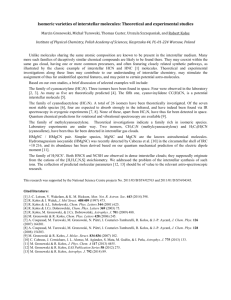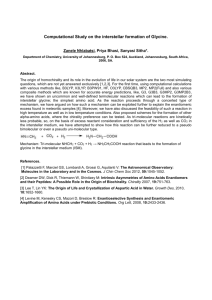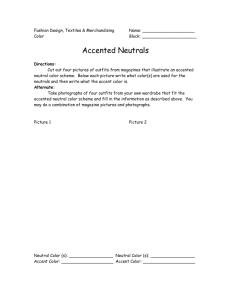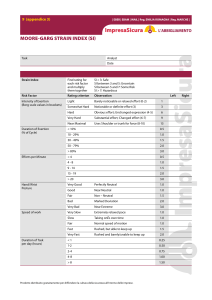Consolidation of the Physical Interstellar Medium Parameters and Neutral Gas... – Coordinated Effort at ISSI
advertisement
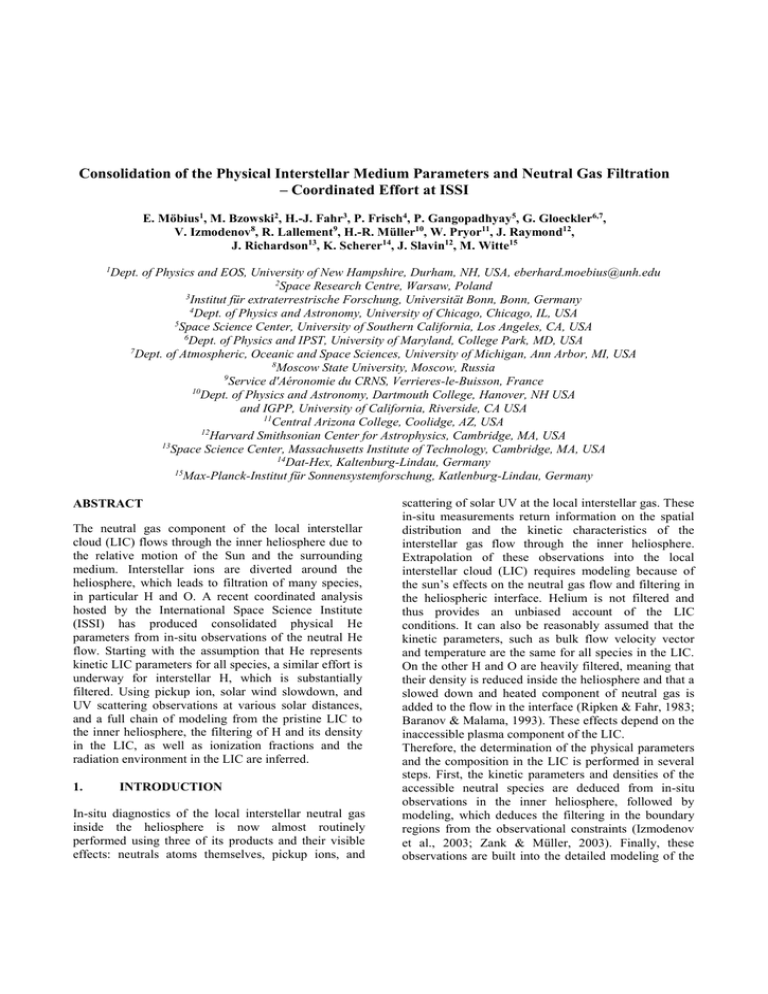
Consolidation of the Physical Interstellar Medium Parameters and Neutral Gas Filtration – Coordinated Effort at ISSI E. Möbius1, M. Bzowski2, H.-J. Fahr3, P. Frisch4, P. Gangopadhyay5, G. Gloeckler6,7, V. Izmodenov8, R. Lallement9, H.-R. Müller10, W. Pryor11, J. Raymond12, J. Richardson13, K. Scherer14, J. Slavin12, M. Witte15 1 Dept. of Physics and EOS, University of New Hampshire, Durham, NH, USA, eberhard.moebius@unh.edu 2 Space Research Centre, Warsaw, Poland 3 Institut für extraterrestrische Forschung, Universität Bonn, Bonn, Germany 4 Dept. of Physics and Astronomy, University of Chicago, Chicago, IL, USA 5 Space Science Center, University of Southern California, Los Angeles, CA, USA 6 Dept. of Physics and IPST, University of Maryland, College Park, MD, USA 7 Dept. of Atmospheric, Oceanic and Space Sciences, University of Michigan, Ann Arbor, MI, USA 8 Moscow State University, Moscow, Russia 9 Service d'Aéronomie du CRNS, Verrieres-le-Buisson, France 10 Dept. of Physics and Astronomy, Dartmouth College, Hanover, NH USA and IGPP, University of California, Riverside, CA USA 11 Central Arizona College, Coolidge, AZ, USA 12 Harvard Smithsonian Center for Astrophysics, Cambridge, MA, USA 13 Space Science Center, Massachusetts Institute of Technology, Cambridge, MA, USA 14 Dat-Hex, Kaltenburg-Lindau, Germany 15 Max-Planck-Institut für Sonnensystemforschung, Katlenburg-Lindau, Germany ABSTRACT The neutral gas component of the local interstellar cloud (LIC) flows through the inner heliosphere due to the relative motion of the Sun and the surrounding medium. Interstellar ions are diverted around the heliosphere, which leads to filtration of many species, in particular H and O. A recent coordinated analysis hosted by the International Space Science Institute (ISSI) has produced consolidated physical He parameters from in-situ observations of the neutral He flow. Starting with the assumption that He represents kinetic LIC parameters for all species, a similar effort is underway for interstellar H, which is substantially filtered. Using pickup ion, solar wind slowdown, and UV scattering observations at various solar distances, and a full chain of modeling from the pristine LIC to the inner heliosphere, the filtering of H and its density in the LIC, as well as ionization fractions and the radiation environment in the LIC are inferred. 1. INTRODUCTION In-situ diagnostics of the local interstellar neutral gas inside the heliosphere is now almost routinely performed using three of its products and their visible effects: neutrals atoms themselves, pickup ions, and scattering of solar UV at the local interstellar gas. These in-situ measurements return information on the spatial distribution and the kinetic characteristics of the interstellar gas flow through the inner heliosphere. Extrapolation of these observations into the local interstellar cloud (LIC) requires modeling because of the sun’s effects on the neutral gas flow and filtering in the heliospheric interface. Helium is not filtered and thus provides an unbiased account of the LIC conditions. It can also be reasonably assumed that the kinetic parameters, such as bulk flow velocity vector and temperature are the same for all species in the LIC. On the other H and O are heavily filtered, meaning that their density is reduced inside the heliosphere and that a slowed down and heated component of neutral gas is added to the flow in the interface (Ripken & Fahr, 1983; Baranov & Malama, 1993). These effects depend on the inaccessible plasma component of the LIC. Therefore, the determination of the physical parameters and the composition in the LIC is performed in several steps. First, the kinetic parameters and densities of the accessible neutral species are deduced from in-situ observations in the inner heliosphere, followed by modeling, which deduces the filtering in the boundary regions from the observational constraints (Izmodenov et al., 2003; Zank & Müller, 2003). Finally, these observations are built into the detailed modeling of the Table 1: Consensus parameters for He in the LIC Parameter He Flow Direction: He Flow Speed: He Temperature: He Density: Observed Value Longitude = 74.68±0.56o Latitude = - 5.31±0.28o vHe∞ = 26.24±0.45 km/s THe∞ = 6300±390 K nHe∞ = 0.0148±0.002 cm-3 ionization and radiation environment outside the heliosphere (Slavin & Frisch, 2002). The effort of this ISSI Team will add a consolidated neutral H density (nH) at the termination shock, better constraining parameters in the LIC, and it coordinates the different modeling approaches. 2. COORDINATED ANALYSIS OF THE INTERSTELLAR HE PARAMETERS Because of its unchanged access to the inner heliosphere and the availability of three observation methods the first comprehensive physical parameter set in the LIC has been obtained for He. Simultaneous observations of interstellar He as neutral gas, pickup ions, and of its UV glow with Ulysses, ACE, EUVE, and SOHO were recently used to derive a consensus set of He parameters for the LIC (Möbius et al., 2004). The results are compiled in Table 1. Direct observation of the neutrals provides the most accurate account of the kinetic He parameters (Witte, 2004), whereby Doppler-dimming observations are fully consistent with the neutral gas results (Vallerga et al., 2004). The density is obtained most accurately from He2+ pickup ion observations, which do not require an absolute calibration (Gloeckler et al., 2004). The neutral gas result is identical with the pickup ion result, but carries somewhat larger uncertainty. To achieve consistent results with all methods required the assumption of additional ionization through electron impact and of a latitudinal variation of the ionization rates. 3. CONSTRAINTS FOR THE PARAMETERS AND IONIZATION LIC Making the reasonable assumption that the kinetic parameters of all species in the LIC are represented by those obtained for He, the only missing parameter for H, the majority species of the neutral interstellar gas, is its density. As a stepping stone before talking into account any filtration the H density in the heliosphere at large distance must be determined. Current values for the neutral H density nHTS at the termination shock, obtained from pickup ion (Gloeckler and Geiss, 2004) and solar wind slowdown observations (Wang & Richardson, 2003), and the recent encounter of Voyager 1 with the termination shock (TS) provide already increasingly tighter constraints for the neutral and ionized hydrogen (nH and nH+) in the LIC. Izmodenov et Methods Neutrals, UV, Pickup Neutrals, UV Neutrals, UV Neutrals, UV Pickup, Neutrals, UV al. (2003) combined nHTS = 0.095 cm-3 with nH = 0.18 cm-3 and nH+ = 0.06 cm-3 and found a TS distance in the Voyager direction of 95 AU, very close to the actual encounter. Since this evaluation of the parameters is based on a model of the filtration of neutral atoms on their way into the heliosphere it also constrains the filtration process. The composition of the neutral interstellar gas as obtained from pickup ion and anomalous cosmic ray observations constrains models for the ionization fraction of H and He and their spatial structure in the local interstellar medium (LISM), which includes the LIC that embeds the heliosphere (Slavin & Frisch, 2002). Adding to these constraints the consolidated He parameters have now considerably narrowed the available parameter space. Current best fits of the He parameters to the model, which take into consideration the composition of the neutral interstellar gas from pickup ion and anomalous cosmic ray observations, are consistent with a total H density (neutral + ions) nHTot = 0.22 or = 0.24 cm-3 and a magnetic field B = 0.24 -3.7 µG in the LISM (Slavin & Frisch, 2005). Narrowing the uncertainty for nH and consolidation as well as coupling of the TS distance to the heliosphere dynamics will further improve these results and will allow a better deduction of B. 4. EFFORT TO CONSOLIDATE THE H DENSITY AT THE TERMINATION SHOCK After compiling a benchmark set for the interstellar He parameters a key quantity that constrains the physical state in the LIC and the filtering is the neutral H density at large distances in the heliosphere, i.e. at the termination shock. It can be determined with several different in-situ methods. From pickup ion observations a neutral H Density of nHTS = 0.095±0.01 cm-3 has been derived (Gloeckler and Geiss, 2004). This result is sensitive to the actual ionization rates and radiation pressure in the inner heliosphere. Observations with Ulysses at 1.3-5.4 AU will be used to adapt simultaneously the local density and the gradient in the modeling to improve this result. Solar wind slowdown observations on Voyager 2 have put the neutral H density at nHTS = 0.09±0.02 cm-3 (Richardson et al., 1995; Wang and Richardson, 2003). This result is sensitive to the interstellar neutral gas and solar wind modeling. Improvements can be achieved by adapting the two-components of interstellar H and fitting simultaneously to the absolute value and the gradient of the slowdown. The same parameters will be used in a consolidated modeling for both in-situ methods, pickup ion and slowdown observations. From UV backscattering on Voyager a density nHTS = 0.075 cm-3 has been derived (Gangopadhyay et al., 2004). This result is strongly sensitive to the absolute calibration of the UV sensors as well as to the modeling of the radiation transport and of the heliospheric interface. Within the ISSI Team a new approach is being used that does not require absolute calibration. We will make use of the availability of Ly backscatter observations from 1 AU (SOHO), via 1.3 - 5.4 AU (Ulysses), 5 AU (Galileo at Jupiter), 9 AU (Cassini at Saturn), and 39 - 55 AU (Voyager) to track the damping of the Ly modulation due to the sun’s activity regions and its rotation, as shown schematically in Fig. 1. The damping of this modulation with distance is a measure of the local neutral H density. Comparing all three results with the same model assumptions that include the appropriate variations of ionization rates and radiation pressure with their anisotropy should provide a consensus value for nHTS. 5. EFFORT TO CONSOLIDATE HELIOSPHERIC MODELING Figure 1. Schematic view of the attempt to use the modulation of the sun’s UV radiation due to the motion of activity regions with the rotation of the sun. Because of scattering at the interstellar H atoms intensity of the illuminating active region fades out with distance from the sun, like the beacon of a lighthouse in fog. The decrease of the modulation with distance from the sun is a measure of the interstellar H density nH, which can be obtained without the need of absolute calibration through modeling and observations of backscattered Ly radiation from SOHO, Ulysses, Galileo, Cassini, and Voyager. An example of the modulation of Ly radiation at 1 AU, based on the SOLAR 2000 model (Tobiska, 2004) is shown in the inset near Earth. The decrease of the modulation is sketched qualitatively in the insets at larger distances. 6. THE All results from these observations are model dependent, in particular, the extrapolation to the LISM. Therefore, the ISSI Team has also mounted an attempt to a) use the same model assumptions for all analysis steps and b) evaluate how different model approaches return the same critical heliospheric parameters, such as the distance of TS, HP, and BS, for the same parameter set. Models that include the behavior of neutral gas are either fully kinetic for the neutral component (e.g. Baranov and Malama, 1993; Izmodenov et al., 2005), treat the neutrals as multiple fluid components (e.g. Zank and Müller, 2003), or keep the neutral distributions after the last interaction in a general multifluid approach (e.g. Fahr et al., 2000). A direct comparison shows that the difference for the distances of the boundaries between the two model families can be kept to approx. 10% or below, if at least three different neutral fluids are used, but noticeable differences remain (Alexashov & Izmodenov, 2005). In addition, pure fluid implementations do not include the influx of neutrals from all directions out of the H wall and the heliosheath, because neutral fluids follow only flow lines (as sketched in Fig. 2). Thus a fully kinetic approach is needed definitely to simulate energetic neutral atom observations, as planned with the Interstellar Boundary Explorer (IBEX) (McComas et al., 2005). In addition, it will be assessed through comparison of stationary and time-dependent modeling how strongly temporal variations of the solar wind dynamics as a function of the solar activity cycle influence the H inflow, the ENA distributions, and the model dependent results for the interstellar parameters (e.g. Scherer & Fahr, 2002; Fahr & Scherer, 2004). FUTURRE DEVELOPMENTS A consolidation of the LIC parameters, including the H density, will allow a re-calibration of past UV backscattering observations that have the longest history. In this way potential small scale variations in the LIC parameters and their temporal history can be constrained. The next step with substantial improvements in the knowledge of the interstellar parameter set and in the understanding of the filtering will become possible with the launch of IBEX, which will provide the first direct measurement of the interstellar O flow velocity vector inside the heliosphere (McComas et al., 2005). The recent observation that the flow direction of interstellar H inside the heliopshere is different from that of He, points to an inclined interstellar magnetic field (Lallement et al., 2005), This effect has recently been modeled quantitatively by Izmodenov et al. (2005). Based on this conclusion, improved observations of this diverted flow and of a related asymmetry of the heliosphere in the light of ENAs will allow a much better deduction of magnetic field strength and direction, whose knowledge is still relatively uncertain. 7. ACKNOWLEDGEMENTS Figure 2. Schematic view of the heliosphere and the incoming ISM neutral gas flow. The upper half indicates the behavior of the gas flow, as seen through full kinetic modeling of the neutrals, while the lower half shows their behavior as seen through multi-fluid modeling. The key difference between the two models is that kinetic models describe the full velocity distributions, which allows to see the arrival of secondary neutrals from all sides out of the interface layer, while strict multi-fluid models represent the gas by the bulk flow of its important components along their flow lines. In this picture secondary neutrals would flow mostly along the boundaries and reach 1 AU only from the nose, unless the velocity distribution of the neutrals is maintained after the last interaction between neutrals and ions. The authors would like to thank the International Space Science Institute (ISSI) for the support of this activity. E. M. would like to thank the staff at ISSI and at the Physics Institute of the University of Bern for their hospitality during a sabbatical visit and thankfully acknowledges support by the Hans-Sigrist Stiftung. This work was supported under NASA grants NAG5-12929, NAG5-10890, NAG5-12879, NAG5-13611 and NNG05GD69G, under the Polish SCSR grant 1P03D00927, Russian Grant RFBR 04-02-16559, INTAS Grant 2001-0270. ……. 8. REFERENCES Alexashov D. and Izmodenov V.V., Astron. Astrophys., in press, 2005. Baranov V.B. and Malama Y.G., J. Geophys. Res., Vol. 98, 15157 - 15163, 1993. Dalaudier F., Bertaux J.L., Kurt V.G. and Mironova E.N., Astron. Astrophys, Vol. 134, 171 - 184, 1984. Fahr H.-J., Kausch T. and Scherer H., Astron. Astrophys. Vol. 357, 268 - 282, 2000. Fahr H.-J. and Scherer K., ASTRA, Vol. 1, 1 - 12, 2004. Gangopadhyay P., Izmodenov V.V., Quemerais E., Gruntman M.A. and Judge D.L., Adv. Space Res., Vol. 34, 94 - 98, 2004. Gloeckler G. and Geiss J., Adv. Space Res., Vol. 34, 53 - 60, 2004. Gloeckler G., et al., Astron. Astrophys., Vol. 426, 845 854, 2004. Izmodenov V.V., Malama Y.G., Gloeckler G. and Geiss J., Astrophys. J., Vol. 954, L59 - L62, 2003. Izmodenov V.V., Malama Y.G. and Ruderman M.S., Astron. Astrophys., Vol. 429, 1069 - 1080, 2005. Izmodenov V.V., Alexashov D. and Myasnikov A., Astron. Astrophys., in press, 2005. Lallement R. and Bertin P., Astron. Astrophys., Vol. 266, 479 - 485, 1992. Lallement, R., Raymond J.C., Vallerga J., Lemoine M., Dalaudier F. and Bertaux J.L., Astron. Astrophys., Vol. 426, 875 - 884, 2004. Lallement R., Quémerais E., Bertaux J. L., Ferron S., Koutroumpa D., and Pellinen R.. Science, Vol. 307, 1447 - 1449, 2005. Linsky J.L., et al., Astrophys. J., Vol. 402, 694 - 709, 1993. McComas D., et al., Proceedings of the Solar Wind 11/SOHO 16 Symposium, this volume, 2005. Möbius E., et al., Astron. Astrophys., Vol. 426, 897 908, 2004. Richardson J.D., Paularena K.I., Lazarus A.J. and Belcher J.W., Geophys Res. Lett.,Vol. 22, 1469 1472, 1995. Ripken H. W. and Fahr H.-J., Astron. Astrophys. Vol. 122, 181 - 192, 1983. Scherer K. and Fahr H.-J., Geophys. Res. Lett., Vol. 29, doi:10.1029/2002GL016073, 2002. Slavin J. and Frisch P.C., Astrophys. J., Vol. 565, 364 379, 2002. Slavin J. and Frisch P.C., in prep., 2005. Tobiska W.K., Adv. Space Res., Vol. 34, 1736 - 1746, 2004. Vallerga J., et al., Astron. Astrophys., Vol. 426, 855 866, 2004. Wang C. and Richardson J.R., J. Geophys. Res., Vol. 108, 1058, 10.1029/2002JA009322, 2003. Witte M., Astron. Astrophys., Vol. 426, 835 - 844, 2004. Zank G.P. and Müller H.-R., J. Geophys. Res., Vol. 108, 1240, 10.1029/2002JA009689, 2003.

